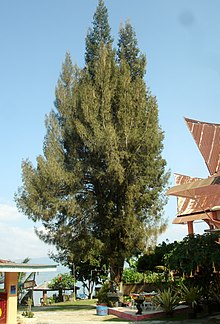| Casuarina junghuhniana | |
|---|---|

| |
| Casuarina Junghuhniana seen in Ambarita, Samosir | |
| Conservation status | |
 Least Concern (IUCN 3.1) | |
| Scientific classification | |
| Kingdom: | Plantae |
| Clade: | Tracheophytes |
| Clade: | Angiosperms |
| Clade: | Eudicots |
| Clade: | Rosids |
| Order: | Fagales |
| Family: | Casuarinaceae |
| Genus: | Casuarina |
| Species: | C. junghuhniana |
| Binomial name | |
| Casuarina junghuhniana Miq. | |
| Subspecies | |
| |
| Synonyms | |
| |
Casuarina junghuhniana, the mountain ru or red-tipped ru, is a tree in the family Casuarinaceae that originated in Java and Lesser Sunda Islands. The species has been introduced to Pakistan and Bangladesh.
Description
Casuarina junghuhniana is an evergreen tree growing to 15–35 m (50–115 ft) tall. The foliage consists of slender, much-branched green to grey-green twigs 0.8–1 mm (0.032–0.039 in) diameter, bearing minute scale-leaves in whorls of 9–11. It is dioecious and The flowers are produced in small catkin-like inflorescences. The fruit is an oval woody structure, superficially resembling a conifer cone made up of numerous carpels each containing a single seed with a small wing 4–5 mm (0.16–0.2 in) long. Unlike Casuarina equisetifolia, Mountain Ru (C. junghuhniana) has a narrower canopy, small and neat branches. It has a straight and knotless trunk.
Like some other species of the genus Casuarina, C. junghuhniana is an actinorhizal plant able to fix atmospheric nitrogen. In contrast to species of the plant family Fabaceae (e.g., beans, alfalfa, Acacia), Casuarina harbours a symbiosis with a Frankia actinomycete.
Taxonomy
There are two subspecies:
- Casuarina junghuhniana subsp. junghuhniana distributed in Java, Bali, Lombok, Sumbawa and Flores
- Casuarina junghuhniana subsp. timorensis found in Timor, Wetar, Sumba and Sumbawa
Distribution and habitat
Casuarina junghuhniana is native to Java and the Lesser Sunda Islands. The species has been introduced to Pakistan and Bangladesh as a restoration of degraded forest areas.
Uses
Popularly grown as an ornamental plant and a windproof line. The wood of this tree is used for shingles, fencing, and is said to make excellent hot-burning firewood.
References
- ^ Oldfield, S. (2022). "Casuarina junghuhniana". IUCN Red List of Threatened Species. 2022: e.T175671725A187270368. Retrieved 21 March 2023.
- "Taxonomy browser (Casuarina junghuhniana)". www.ncbi.nlm.nih.gov. National Center for Biotechnology Information. Retrieved 2021-01-26.
- "Casuarina junghuhniana Miq". www.gbif.org. GBIF. Retrieved 2021-01-26.
- ^ Normita Thongtham. Casuarina and effects Bangkok Post, 23 February 2558.
- Pl@ntUse Casuarina junghuhniana (PROSEA) Retrieved 4 January 2564.
- ^ บ้านและสวน สนประดิพัทธ์ อมรินทร์พริ้นติ้งแอนด์พับลิชชิ่ง 4 July 2559.
- National Academy of Sciences. Casuarinas: Nitrogen-Fixing Trees for Adverse Sites. National Academy Press, Washington D.C., 1984.
- Winrock International. Casuarina junghuhniana – a Highly Adaptable Tropical casuarina NFTA 95-01, January 1995.
- Plants of the World, Kew Science Casuarina junghuhniana Miq. Retrieved 3 January 2564.
- Useful Tropical Plants Database Casuarina junghuhniana 13 June 2019.
| Taxon identifiers | |
|---|---|
| Casuarina junghuhniana |
|